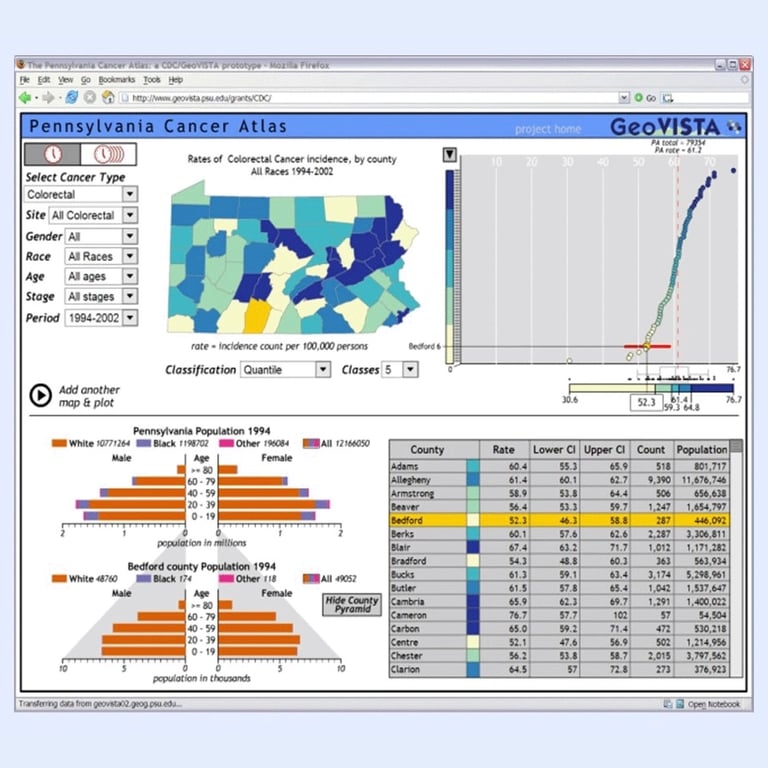AI & Geospatial Solutions Innovative Public Health Solutions
In today's rapidly evolving public health landscape, innovative solutions to tackle resource constraints are more crucial than ever. Public health organizations often struggle with limited budgets, a shortage of skilled professionals, inadequate infrastructure, and logistical challenges. Amid these difficulties, integrating artificial intelligence (AI) and geospatial technologies transforms vast data repositories into actionable insights that optimize health outcomes.
TECH FOR PUBLIC HEALTH
Scott Pezanowski
5/8/20243 min read


In today's rapidly evolving public health landscape, the need for innovative solutions to tackle resource constraints is more crucial than ever. Public health organizations often struggle with limited budgets, a shortage of skilled professionals, inadequate infrastructure, and logistical challenges. Amid these difficulties, integrating artificial intelligence (AI) and geospatial technologies transforms vast data repositories into actionable insights that optimize health outcomes.
Understanding the Reality of Resource Constraints
The global healthcare sector faces diverse challenges that restrict its ability to respond effectively to health crises:
Limited Financial Resources: Budget constraints reduce the ability to invest in innovative tools or recruit additional skilled personnel.
Shortage of Skilled Professionals: A critical shortage of doctors, nurses, and public health experts leaves a gap in essential care services.
Inadequate Infrastructure: Many regions need proper physical and technological infrastructure for efficient health service delivery.
Data Management Issues: Outdated systems often impede quality data collection and evidence-based decision-making.
Supply Chain Challenges: The logistics of distributing medical supplies can become bottlenecks, particularly in remote or expansive regions.
These issues demand innovative technologies that optimize available resources, amplify the impact of existing workers, and streamline operations.


AI with Geospatial technologies scale up analytics
AI and geospatial technologies address public health challenges through:
Optimized Resource Use: By analyzing vast geospatial-enabled data repositories, AI identifies where medical resources are needed most, ensuring efficient allocation.
Enhanced Decision-Making: Predictive analytics models disease trends, enabling health leaders to anticipate and mitigate outbreaks promptly.
Precise Disease Surveillance and Prediction: Geospatial data provides critical insights into the geographic spread of diseases, allowing health organizations to focus on targeted interventions.
Training and Diagnostics: AI can help scale up the training of health professionals, while automated diagnostics enable less specialized workers to perform complex tasks with accuracy.

Case Studies: Success Stories in Implementation
SensePlace3: Crisis Management in Real Time


My work with SensePlace3 showcased the power of AI and geospatial data in harnessing real-time social media analytics. By analyzing explicit and implicit geographic information from Twitter, SensePlace3 filters and prioritizes relevant data, offering crucial insights to public health professionals. This focus on geographic information helped pinpoint crisis-affected areas needing immediate attention and allow for efficient resource distribution.
US Cancer Atlas: Visual Analytics for Public Awareness


The Pennsylvania and US Cancer Atlas used geovisual analytics to monitor cancer incidence in real-time. Its user-friendly interface ensures that policymakers and the public can access accurate, actionable data. This tool raises awareness, enhances evidence-based policy decisions, and improves educational outreach.
Strategies for Successful Integration
For public health organizations aiming to integrate AI and geospatial technologies into their operations, here are some critical steps:
Infrastructure and Budgeting: Invest in geographic information systems and allocate sufficient funds to ensure IT infrastructure can manage applications.
Pilot Projects: Start with pilot projects focusing on disease surveillance and refining data collection processes.
Data Quality and Privacy: Maintain comprehensive, high-quality data while prioritizing privacy and security measures.
Training and Collaboration: Provide IT and health professionals training to leverage these new tools effectively and foster partnerships with tech companies and academic institutions to share best practices.
The Future of AI and Geospatial in Public Health
Advancements in AI and geospatial technologies will revolutionize disease surveillance and predictive analytics, offering real-time insights at finer spatial resolutions. Cloud computing will further democratize access to these technologies, ensuring high-performance solutions are available even in low-resource settings. However, ethical considerations and enhanced data privacy will remain paramount in providing equitable and effective implementation.


A Call to Action
These modern data analytics hold immense potential for transforming public health by optimizing resource use, improving disease prediction, and enabling efficient emergency responses. Public health leaders must embrace this innovative technology strategically to break free from resource constraints and foster healthier global communities.
By leveraging AI on geospatial data and integrating geospatial analytics, the healthcare sector can tackle current challenges while laying a solid foundation for future resilience and continuous improvement.
Let's partner to drive the future of public health together.
Check out the video below to learn more about succeeding despite resource limitations.


